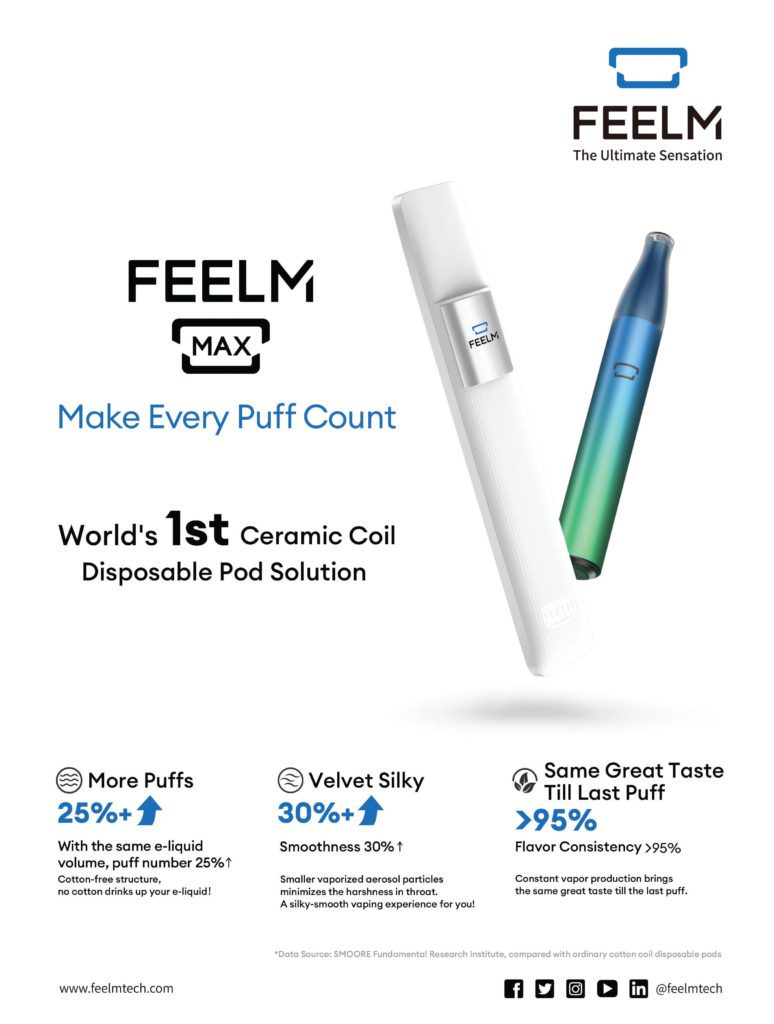Embracing E-cigarettes
- Harm Reduction This Issue
- August 25, 2023
- 16 minutes read

Credit: Andriano_cz

The success of e-cigarettes as a switching tool in the U.K. offers valuable lessons for the United States.
By Kim Hesse
Electronic nicotine-delivery systems (ENDS) have been discussed and disparaged for years in public health and policy circles in the United States, especially regarding their potential health risks. For many, the legacy of distrust from tobacco companies’ historic lack of transparency on the health impact of cigarettes has led to skepticism about the safety of ENDS products. And yet, we could learn from the accumulation of research studies and real-world evidence, which now makes it hard to deny that ENDS products are a better choice than combustible cigarettes.
The U.S. can look to the United Kingdom and Sweden for a pathway to positive public health impact. The U.K. government recommends the use of e-cigarettes as a smoking cessation tool. For example, current advice from the U.K.’s National Institute for Health and Care Excellence supports the use of e-cigarettes as a stop-smoking intervention. Sweden further leads the way in transitioning smokers to less harmful pouched tobacco products such as snus.

The guidelines state that e-cigarettes are a safer alternative to traditional cigarettes and that they should be recommended as a quit-smoking aid to smokers who are unable or unwilling to quit using other methods. The guidelines also recommend that e-cigarettes should be used in conjunction with other smoking cessation services, such as counseling and nicotine-replacement therapy (NRT). Many studies have shown an association between e-cigarette use and a significant reduction in the number of people smoking traditional cigarettes, particularly among the young.
One of the main reasons for the positive impact of e-cigarettes in the U.K. is the way they have been regulated. E-cigarettes are subject to safety and quality standards and are available only to adults. In addition, e-cigarettes are taxed at a lower rate than traditional cigarettes, which makes them more affordable for smokers who are looking to quit. This combination of regulation, taxation and availability has made e-cigarettes a popular choice for U.K. smokers eager to give up their habit.
By comparison, the U.S. has work to do in order to achieve the same level of impact being seen in the U.K. The first task before us is to debunk the myths that stand in the way.
Myth 1: The risks associated with the use of ENDS products are unknown—untrue! According to Sairah Salim-Sartoni of Salim-Sartoni Associates, there is at least 10 years’ worth of studies providing evidence that ENDS products are less damaging than combustible cigarettes. Salim-Sartoni points to the independent evidence review conducted by Kings College London in the U.K., which included approximately 400 studies.[1]
The authors reported: “Vaping poses only a small fraction of the risk of smoking and is at least 95 percent less harmful than smoking (that is, smoking is at least 20 times more harmful to users than vaping).” Of course, it is important to note that e-cigarettes are not without risks. They still contain nicotine, which is an addictive substance. However, compared to traditional cigarettes, e-cigarettes are a safer alternative. As Robert M. Califf, head of the U.S. Food and Drug Administration, said in a Feb. 24, 2023, press release, “Certain e-cigarettes may help adult smokers transition completely away from, or significantly reduce their use of more harmful combusted cigarettes.”[2]
Myth 2: Big Tobacco started the vaping industry—false! The ENDS industry started with a few small companies creating products that slowly became popular with smokers who were trying to quit combustibles. The ENDS products helped smokers transition away from combustibles, and news spread until the industry became what it is today. In reality, the legacy cigarette companies have been in the alternative nicotine market for only a relatively short period of time. Initially, these multinational firms did not see e-cigarettes as a sustainable product and thought they would eventually disappear. It was only in more recent years that Big Tobacco began investing heavily in this market.
Myth 3: Nicotine causes cancer—not true! Tar from combustible cigarettes is the cancer-causing agent. Additionally, combustible cigarettes produce far greater harmful and potentially harmful constituents than those produced by ENDS products. The evidence is inadequate to infer the presence or absence of a causal relationship between exposure to nicotine and risk for cancer.3
If we can move beyond the myths and misconceptions to accept these truths, then stakeholders in the U.S. should be thinking about social media and other campaigns that spread the facts about the positive impact that e-cigarettes can have on public health. John Dunne, director general of the U.K. Vaping Industry Association, attributes the prevalence of the above myths in the U.S. in part to sensationalized headlines generating more clicks and attention than factual reporting. “‘Vaping causes you to grow a third ear’ will get more clicks than a headline reading ‘Vaping is the best thing in the world,’” he said.
“It seems the only ones wanting to speak positively about the vaping industry is the industry itself,” Dunne continued. “However, it is crucial to change this narrative and focus on education and good research to inform smokers, the public and physicians alike about the health benefits of switching to ENDS products.”

If the U.S. were to turn away from outdated myths and follow the U.K.’s guidelines on e-cigarettes, it could have a similarly positive impact on public health. Currently, e-cigarette regulations differ from state to state. However, if e-cigarettes were approved as a switching tool on a federal level, it could help to reduce the number of people smoking traditional cigarettes and improve public health.
In order to gain the benefits that the U.K. has seen, though, the U.S. must acknowledge and address concerns around the impact on youth. According to the study “Changes in Youth Smoking 1976–2002: A Time Series Analysis” by Fred C. Pampel and Jade Aguilar, youth cigarette smoking dropped in the late 1970s and leveled off to new lows in 1980. However, we saw an increase in smoking in the 1990s, and by 1997, a quarter of the youth population was reported to be smoking daily. While this news may seem alarming, let’s compare it to ENDS product use among youth today. “The youth vaping epidemic: addressing the risk of e-cigarettes in schools” reported that 27.5 percent of the youth population regularly use e-cigarettes. It further states that this number is approximately 22 percent higher than high schoolers who smoke normal cigarettes.”4 While the Brookings article does state that 27.5 percent of youth regularly use e-cigarettes, this does not match what is in the paper behind the data.
The 27.5 percent number applies only to high school students; middle school students were also surveyed and e-cigarette use within this group was much lower. From the data, 3,611 high school and middle school kids had past 30-day (i.e., “current”) e-cigarette use; this is approximately 19 percent of the kids’ population. The data also show that approximately 4 percent of kids smoked cigarettes in the past 30 days. But only a proportion of kids used e-cigarettes regularly (on 20 or more of the past 30 days). Given these data, rough calculations show that less than 6 percent of all kids were using e-cigarettes regularly, which is a lot lower than the reported 27.5 percent. Daily use of e-cigarettes is even lower, at approximately 3 percent.
Although individuals younger than 21 should not use tobacco products, youth who are experimenting are choosing a less harmful product than combustible cigarettes. If we remove these products from the U.S. market, this group of experimenters could go back to smoking cigarettes. With or without vape products, experimentation of some sort by youth will occur. This leads us back to the task at hand—to properly educate the public about the risks and benefits of ENDS products.
If we take the lead from our U.K. counterparts, we can learn from their experience in supporting e-cigarettes as a switching tool. There, they learned that the secret to getting people permanently off combustible products, such as traditional cigarettes, is to provide an enjoyable experience. Some of the side effects of NRTs can cause people to stop using them and go back to smoking. However, for some, e-cigarettes can provide an enjoyable experience without negative side effects.
The reason why ENDS products help many combustible smokers switch from traditional cigarettes is complex, according to both Dunne and Salim-Sartoni, who believe it is a combination of effective nicotine delivery and “the hand-to-mouth action.” For many smokers, this action is very important to keep when trying to limit or eliminate the smoking habit.
Others may want to eliminate the action and try to use only nicotine gum, patches, lozenges or pharmaceuticals. However, Salim-Sartoni said the chance of success increases if these cessation options are used in combination with ENDS or a spray.
A recent U.K. smoking cessation campaign supports this approach. Earlier this year, the Department of Health and Social Care announced it would provide nearly one in 5 of all smokers in England with a vape starter kit alongside behavioral support to help them kick the habit. Additionally, pregnant women are being offered financial incentives to quit smoking. The overarching goal is to reduce smoking rates in the U.K. to 5 percent or less by 2030.5
Despite support for ENDS as a cessation device, the U.K. medical community still has concerns, according to Salim-Sartoni. Physicians believe that ENDS have great potential, but they are unsure which product to recommend. They would like to see some standards and have assurances that the products they are recommending are truly safer alternatives.
The experience of the pharmaceutical industry may offer some guidance in this respect. When administering a drug, the pharmacist and physician know the potential side effects, and these are weighed against the benefit of the drug being prescribed. Pharmacists and physicians in the U.K. would like to see similar information on ENDS products and would like some reassurance that they are providing the best possible information to their patients and are guiding them to a safer alternative.
As an industry, we need to assess how people are using ENDS products on a wider scale. Creating acceptable levels of use or proper dosing formulas based on the specific products available on the market would be a good first step in educating the public on the impact of ENDS products. Sharing information regarding ingredients and compounds being produced by the products will allow consumers to compare and choose according to quality information.
Ultimately, the key is to work together to reduce the overall harm caused by tobacco use. This means educating the public, promoting switching from combustible cigarettes and investing in research to find new ways to ensure the safety of ENDS products. If we do not work together, more lives will be lost to combustible tobacco products.
It’s time to wake up, educate and act.
[1] www.gov.uk/government/publications/nicotine-vaping-in-england-2022-evidence-update
2 www.fda.gov/news-events/press-announcements/fda-outlines-steps-strengthen-tobacco-program
3 www.ncbi.nlm.nih.gov/books/NBK44698
4 https://jamanetwork.com/journals/jama/article-abstract/2755265
5 www.ncbi.nlm.nih.gov/pmc/articles/PMC2696267

